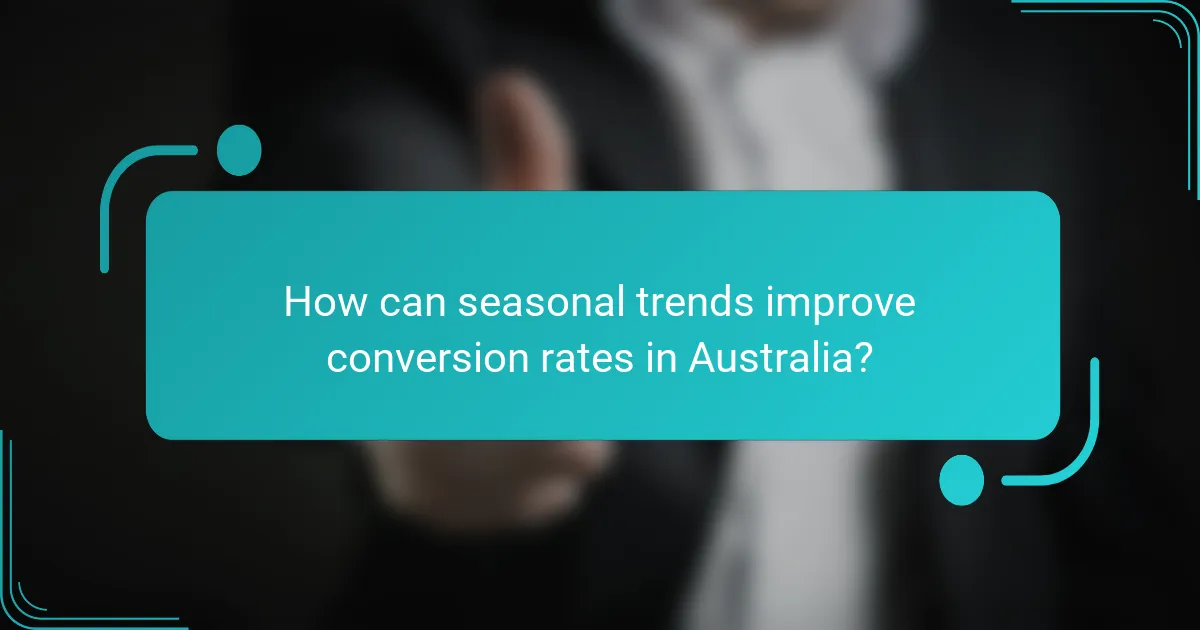Analyzing seasonal trends is crucial for businesses in Australia looking to boost conversion rates by aligning their marketing strategies with consumer behaviours during key times of the year. By leveraging data analytics and understanding the impact of significant events like Christmas and Easter, companies can effectively tailor their approaches to meet increased demand and emotional connections, ultimately enhancing sales and customer engagement.

How can seasonal trends improve conversion rates in Australia?
Seasonal trends can significantly enhance conversion rates in Australia by aligning marketing efforts with consumer behaviours and preferences during specific times of the year. By understanding these trends, businesses can tailor their strategies to meet the heightened demand and emotional connections associated with various seasons and festivals.
Understanding consumer behaviour
Consumer behaviour in Australia varies greatly with the seasons, influenced by cultural, social, and economic factors. For instance, during winter, consumers may prioritise products that offer warmth and comfort, while summer might see a surge in demand for cooling appliances and outdoor activities.
Businesses should analyse past sales data to identify patterns in purchasing behaviour. This analysis can reveal peak shopping times and popular product categories, allowing companies to strategise effectively for upcoming seasons.
Leveraging festive seasons
Festive seasons in Australia, such as Christmas and Easter, present unique opportunities for boosting conversion rates. During these times, consumers are more willing to spend on gifts, decorations, and special meals, creating a surge in demand.
To capitalise on this, businesses should launch targeted marketing campaigns that highlight festive offers, discounts, and exclusive products. Utilising social media and email marketing to promote these campaigns can further enhance visibility and engagement.
Utilising weather patterns
Weather patterns play a crucial role in influencing consumer purchases in Australia. For example, during the hot summer months, products like air conditioners, fans, and cool beverages see increased demand, while winter may boost sales of warm clothing and heating appliances.
Businesses can use weather forecasts to time promotions effectively. For instance, launching a sale on cooling products just before a heatwave can drive conversions, as consumers will be actively seeking solutions to cope with the heat.
Adapting marketing strategies
Adapting marketing strategies to align with seasonal trends is essential for maximising conversion rates. This includes adjusting messaging, visuals, and promotional tactics to resonate with the current season or upcoming festivals.
Consider implementing limited-time offers that create urgency or using seasonal themes in advertising to attract attention. Additionally, ensure that your website and online platforms reflect seasonal changes, making it easier for consumers to find relevant products.

What are effective strategies for analysing seasonal trends?
Effective strategies for analysing seasonal trends include utilising data analytics tools, segmenting customers, and conducting competitor analysis. These approaches help businesses in Australia identify patterns and adapt their marketing strategies to enhance conversion rates during peak seasons.
Data analytics tools
Data analytics tools are essential for tracking and interpreting seasonal trends. Platforms like Google Analytics, Tableau, and Power BI allow businesses to visualise data and uncover insights related to customer behaviour during different times of the year.
When using these tools, focus on metrics such as website traffic, conversion rates, and customer engagement. Regularly reviewing these metrics can help identify seasonal spikes and inform targeted marketing strategies.
Customer segmentation
Customer segmentation involves categorising your audience based on demographics, purchasing behaviour, and preferences. By understanding different customer segments, businesses can tailor their marketing efforts to meet specific needs during seasonal peaks.
For example, a clothing retailer in Australia might segment customers into groups based on age and style preferences, allowing for personalised promotions during festivals like Christmas or Easter. This targeted approach can significantly boost conversion rates.
Competitor analysis
Competitor analysis helps businesses understand how their rivals respond to seasonal trends. By monitoring competitors’ marketing strategies, pricing, and promotional activities, companies can identify successful tactics and adapt them to their own approach.
Tools like SEMrush and Ahrefs can provide insights into competitors’ online presence and seasonal campaigns. Regularly analysing these factors can help businesses stay competitive and enhance their conversion rates during key shopping seasons.

Which seasonal events drive sales in Australia?
In Australia, several seasonal events significantly influence consumer purchasing behaviour, leading to increased sales. Key events like Christmas, Easter, and the summer months present unique opportunities for businesses to enhance their marketing strategies and boost conversion rates.
Christmas promotions
Christmas, known as the festive season, is one of the most lucrative times for retailers in Australia. During this time, consumers are inclined to spend on gifts, home decor, and festive attire, making it essential for businesses to launch targeted promotions.
Effective Christmas promotions can include discounts, bundle offers, and loyalty rewards. For instance, offering a 20-30% discount on popular products can attract more customers. Additionally, leveraging social media for festive-themed campaigns can enhance brand visibility and engagement.
Easter marketing campaigns
Easter presents a vibrant opportunity for brands to connect with consumers through creative marketing campaigns. This festival encourages spending on chocolates, gifts, and apparel, making it vital for businesses to align their offerings with the celebratory spirit.
Brands can utilise engaging content, such as videos showcasing Easter celebrations, to resonate with their audience. Special promotions, like “buy one, get one free” on chocolate products or themed gift hampers, can effectively drive sales during this festive period.
Summer sales strategies
Summer in Australia often leads to increased demand for cooling products, travel packages, and summer apparel. Retailers can capitalise on this trend by implementing seasonal sales strategies that cater to the needs of consumers looking to beat the heat.
Offering discounts on air conditioners, coolers, and summer clothing can attract customers. Additionally, running online campaigns that highlight summer essentials can enhance visibility. Consider bundling products for a better deal, such as pairing summer wear with accessories, to encourage higher spending.

How to implement seasonal marketing campaigns?
Implementing seasonal marketing campaigns involves strategically aligning your marketing efforts with specific times of the year to enhance customer engagement and boost conversion rates. Focus on understanding seasonal trends in Australia, tailoring your messaging, and optimising your promotional efforts accordingly.
Creating targeted content
Targeted content is essential for resonating with your audience during specific seasons. Identify key themes relevant to the season, such as festivals, holidays, or weather changes, and create content that reflects these themes. For example, during Christmas, you might focus on themes of celebration and gifting.
Utilise customer data to segment your audience and personalise content. This could include tailored email campaigns or blog posts that speak directly to the interests and needs of different customer groups, enhancing relevance and engagement.
Timing promotions effectively
Timing is crucial for maximising the impact of your seasonal promotions. Launch campaigns ahead of major holidays or events, ideally a few weeks in advance, to build anticipation. For instance, start promoting your New Year offers in late December to capture early shoppers.
Monitor customer behaviour and adjust your timing based on trends. If you notice increased online traffic during a specific period, consider extending your promotions to capitalise on this heightened interest.
Utilising social media platforms
Social media platforms are powerful tools for reaching your audience during seasonal campaigns. Leverage platforms popular in Australia, such as Facebook, Instagram, and WhatsApp, to share engaging content and promotions. Use eye-catching visuals and seasonal hashtags to increase visibility.
Engage with your audience through interactive content like polls or contests related to the season. This not only boosts engagement but also encourages sharing, expanding your reach organically. Regularly analyse performance metrics to refine your strategy for future campaigns.

What metrics should be tracked for seasonal campaigns?
To optimise seasonal campaigns in Australia, it’s essential to track metrics that directly influence conversion rates. Key metrics include conversion rates, customer engagement, and return on investment (ROI), which provide insights into campaign effectiveness and areas for improvement.
Conversion rate analysis
Conversion rate analysis involves measuring the percentage of visitors who complete a desired action, such as making a purchase. For seasonal campaigns, monitor conversion rates closely during peak shopping periods, as they can fluctuate significantly. A typical conversion rate for e-commerce in Australia ranges from 1% to 3%, but this can vary based on the product and season.
To enhance conversion rates, consider A/B testing different campaign elements, such as promotional offers or landing page designs. This helps identify which strategies resonate best with your audience during specific seasons.
Customer engagement metrics
Customer engagement metrics assess how effectively your campaign captures and retains customer interest. Key indicators include click-through rates (CTR), time spent on site, and social media interactions. In Australia, a good CTR for email campaigns can range from 15% to 25%, depending on the industry.
Utilise tools like Google Analytics to track these metrics and adjust your campaigns accordingly. Engaging content, such as seasonal promotions or interactive posts, can significantly boost these metrics and lead to higher conversion rates.
Return on investment (ROI)
ROI measures the profitability of your seasonal campaigns by comparing the revenue generated to the costs incurred. A positive ROI indicates that your campaigns are financially successful. In Australia, aim for an ROI of at least 200% for seasonal promotions to ensure they are worthwhile.
To calculate ROI, use the formula: (Net Profit / Cost of Investment) x 100. Regularly review your ROI to identify which campaigns yield the best results and allocate resources accordingly for future seasonal efforts.
